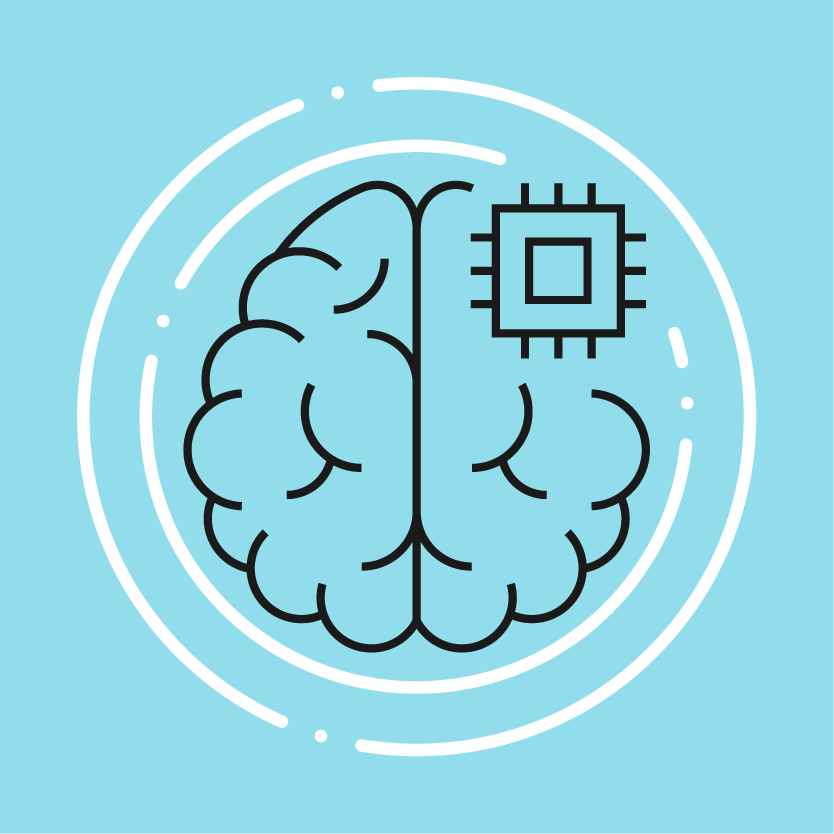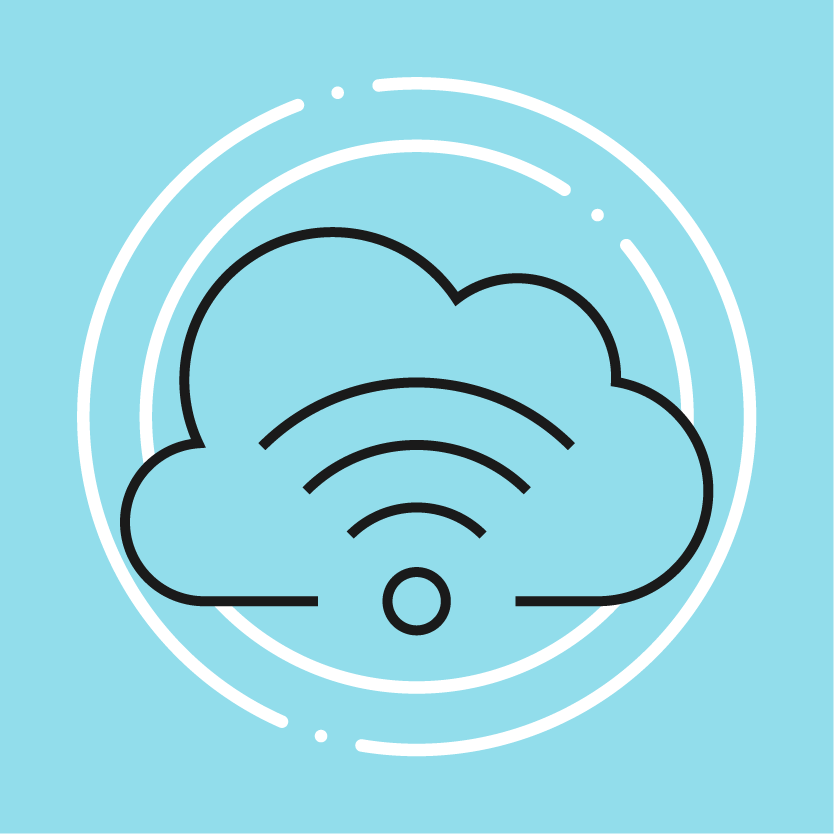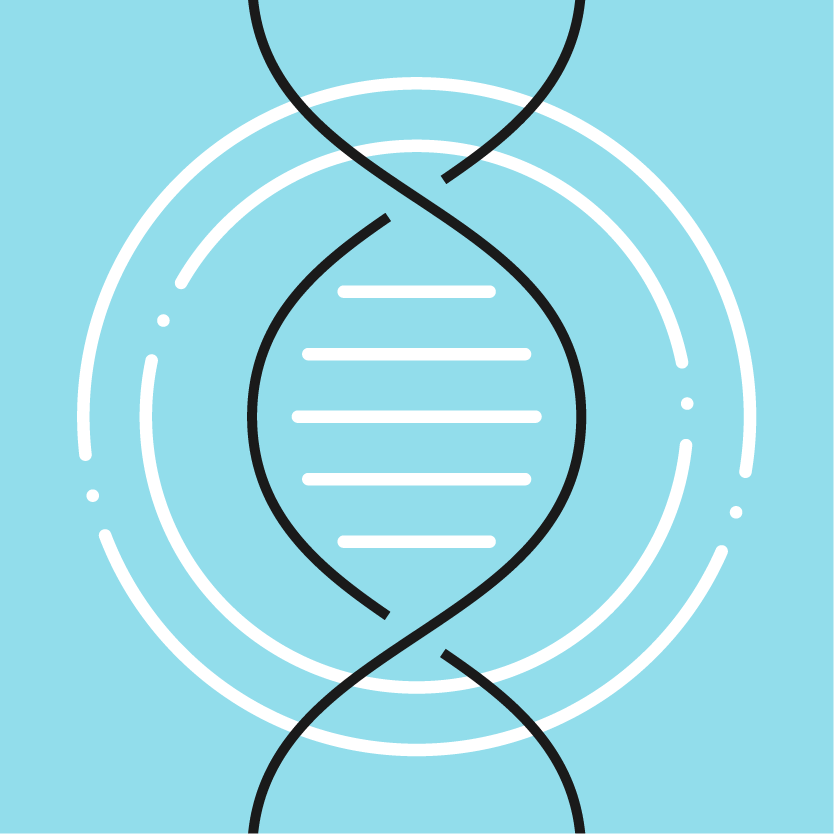Future connections with other ICO priority technologies
Emerging technologies do not develop in a vacuum. As ‘enabling’ technologies 56, quantum technologies are likely to impact many different technologies, sectors and use cases. Given their early stage of development, there is not yet a clear picture of many potential use cases and their impacts, but there are some early indicators. In this section, we explore some plausible (and some more speculative) ways quantum technologies may influence some of our other priority emerging technologies we discussed in previous Tech horizons reports. We also briefly highlight some of the privacy implications of these developments.
Neurotechnology
 There are some near-term neurotechnology use cases for quantum sensing and imaging in the healthcare sector.
There are some near-term neurotechnology use cases for quantum sensing and imaging in the healthcare sector.
Some quantum sensors have the potential to be scaled down into wearable devices 57, and improve the sensitivity of future neurotechnologies in real world situations. For example, researchers have already used advanced quantum brain imaging on drivers using virtual reality, to explore how real time brain patterns while driving change with age 58. There are also ongoing experiments to diagnose autism and analyse brain development in young children, which is not feasible using larger existing systems 59. Non-invasive brain imaging could also improve diagnosis and management of deep-brain conditions, such as Alzheimer’s.
Research into quantum machine learning may also improve classical analysis of neurodata, and accelerate insights into brain patterns and behaviour in real world scenarios.
Beyond this, convergence of neurotechnology and quantum technologies in real world applications is still highly speculative, but could be more plausible in the longer term (15 years or more). For example, in the far future (20 years or more), it is also plausible that quantum magnetic sensors could be integrated into gaming, or even allow us to ‘control’ machines with thought 60. Researchers have even speculated whether, in the far future, certain quantum imaging techniques could enable technologies that can ‘read’ thought 61.
Although not a common area of research, there are examples of experiments in using hybrid and ‘quantum-inspired’ machine learning approaches to improve brain computer interfaces and analysis of neurodata. For example, to improve the ways that brain computer interfaces and classical machine learning algorithms interpret and filter brain signals and images 62. One highly speculative quantum machine learning example is using a future quantum computer to unlock patterns in neurodata that classical machines might not see, or help simulate the complexity of the brain 63. It is still unclear whether this will be a suitable future use case for quantum computing.
Data protection implications
1. Processing neurodata
Such use cases are likely to involve processing neurodata, a novel and intimate type of personal information. Our neurotechnology work surfaced that neurodata is not specifically defined in UK GDPR, but the collection of information from the brain would fall within the concept of “mental identity”. Additional data protection obligations apply if the neurodata is special category data (ie it reveals certain specific types of information, such as information about a person’s health, ethnicity, or sexuality). Whether or not the neurodata is considered special category data is likely to depend on the use case, rather than the underlying technology used to collect it (ie the quantum sensor or specific type of neurotechnology device) 64. Organisations using or exploring quantum technologies in a neurotechnology setting must consider their purpose for processing neurodata, and what level of protections apply. It is also always important to clarify the lawful basis for processing such information.
2. Enhanced capabilities may exacerbate wider neurotechnology risks
The sensitivity offered by quantum sensing (such as the ability to detect individual neurons firing), combined with potential advances in interpreting this information, highlights the extent of granular insight that far-future neurotechnologies could provide. As noted in our neurotechnology work, people may not understand what information is being collected and why. If capabilities are misused or information is inadequately protected, there are concerns about risks of unfair processing (even neurodiscrimination). Other commentators have speculated and raised concerns about risks of unwarranted intrusion or even surveillance of people’s thoughts and behaviours.
3. Security
Post-quantum security is also likely to be an important issue. Neurotechnologies may become more pervasive in future, in both healthcare and non-healthcare settings. Neurodata is an example of high risk information that would need to be kept confidential for a long time, particularly if being transmitted, accessed or stored for further analysis. In addition, processing neurodata may result in a high risk to people’s rights and freedoms (per article 35(1) UK GDPR). It will be important to take appropriate security measures, which may include PQC, and regular deletion and appropriate retention strategies.
Next generation internet of things (IoT)
 In theory, quantum computing could impact on the security of information transmitted by existing and next generation IoT devices, particularly those with a long lifespan such as industrial IoT, or smart buildings. In future, we could see PQC deployed to protect information processed by next generation smart buildings and IoT networks. However, many devices with more limited processing power may not be suitable for an upgrade.
In theory, quantum computing could impact on the security of information transmitted by existing and next generation IoT devices, particularly those with a long lifespan such as industrial IoT, or smart buildings. In future, we could see PQC deployed to protect information processed by next generation smart buildings and IoT networks. However, many devices with more limited processing power may not be suitable for an upgrade.
It is unlikely that many quantum sensing and imaging technologies will be integrated into consumer IoT devices in the next decade. In the next 15 years, we may see pilots of IoT devices incorporating specific types of new quantum sensor or imaging technologies in public spaces, either in addition to, or instead of, current versions. This will depend on factors such as research progress and commercial interest. For example, next generation CCTV using quantum imaging that can detect the presence of (but not identify) people around corners in a hospital or park.
In 10 or more years, we may also see examples of quantum sensing and timing technologies integrated into smart city infrastructure, along with a range of existing sensors and imaging technologies. In particular, advanced quantum clocks could be integrated into communications infrastructure. This could help to better synchronise information flows required for real time device-to-device communication. This has the potential to help enable the ultra-fast processing required for next generation IoT systems and, even further into the future (ie 25 or more years), perhaps immersive or augmented worlds 65.
Some have speculated that next generation quantum sensing technologies could be used for functions such as:
- intrusion detection in sensitive sites;
- more precise real-time location surveillance and monitoring of traffic and transport; or
- pedestrian movement over wider areas, even in fog, traffic, or the dark.
This could enhance, for example, emergency incident response in the event of an accident or natural disaster, and future transport infrastructure planning 66.
Or, quantum sensors could be used to enhance commercial insights. For example, one type of sensor has already been piloted to detect temperature density in a shopping centre to measure shopping trends, without collecting information about identifiable people. However, in these settings, it is unclear whether emerging quantum sensors will offer a significant functional or commercial advantage compared with existing sensors.
Data protection issues
1. Security
In our first Tech horizons report, we highlighted that the security of existing and next generation IoT systems is already a key data protection issue. Depending on the use case, some of these systems can process significant volumes of personal information, which together can give insights into lifestyle and personal habits. They are susceptible to cyber attack, and many consumer IoT systems (such as smart home devices) are still working towards a ‘basic’ level of information security.
There are also specific challenges that will likely impact on the transition to post-quantum security in IoT. In particular, many IoT devices have limited processing power and need to process information quickly to function properly. It is likely that some older and less powerful devices won’t be able to use the new PQC algorithms (eg some basic environmental sensors or appliances). There are options to secure IoT at the server level, but some devices may need to be replaced entirely to secure the entire system. This could be costly and time consuming.
Some commentators suggest it is unlikely that smart home devices will be a significant priority for early transition to quantum secure systems. In the near term, we are more likely to see a transition in industrial IoT or next generation IoT embedded in critical national infrastructure, which have a very long lifespan. We may, therefore, plausibly see a period where the next generation IoT systems most likely to process personal information that are being developed today are not protected against a future quantum computer, even if they are better adapted to current security risks. When deploying IoT, organisations and developers should ensure that they consider both current and future security updates, and adopt measures proportionate to the risks of processing.
2. Surveillance, transparency and data minimisation
Previous publications have highlighted that next generation IoT and smart cities involve high volume information collection from a wide range of sensors and cameras 67.
Adding more advanced quantum capabilities may not add any significant new risk. But, quantum technologies could feasibly pick up additional information or enable additional inferences about people’s movements or use of spaces when combined with other information flows. This only falls within the scope of data protection legislation if the inferences relate to an identifiable person. Inferences about crowds, for example, rarely lead to data protection issues. Organisations can mitigate any potential impact on peoples’ rights and freedoms by being clear and transparent about what they are collecting, and only collecting information that is necessary for the specific purpose (data minimisation).
Genomics
 In the near to medium term future, quantum secure technologies, such as post-quantum cryptography, may be increasingly used by research centres, health services and private genetic testing companies to secure transfers of genomic information. QKD could also be used by some organisations to secure medical records, as has been observed in the US and Japan 68.
In the near to medium term future, quantum secure technologies, such as post-quantum cryptography, may be increasingly used by research centres, health services and private genetic testing companies to secure transfers of genomic information. QKD could also be used by some organisations to secure medical records, as has been observed in the US and Japan 68.
Researchers are also exploring how quantum computing and quantum-inspired classical machine learning could:
- help accelerate different steps in genomic sequencing and analysis (such as piecing together a genome as part of the sequencing process, or classifying sequenced genomic information) 69;
- recognise patterns in genomic sequences; and
- improve insights into interactions between multiple genes 70.
Many of these tasks are very difficult and time consuming for existing computers. Should quantum approaches fulfil their promise, it is hoped that new insights into genomic and other healthcare information could help enable personalised medicine 71.
In the UK, the National Quantum Computing Centre is also supporting a project that is exploring whether in future, hospitals could develop advanced models for genomic analysis in a privacy-preserving way, by combining quantum computing and privacy enhancing techniques 72.
Some genomics problems may turn out to be unsuitable for a quantum computer. Some approaches being tested in the genomics field are relying on (currently theoretical) quantum speedups. Major advances in genomics using quantum machine learning are also highly dependent on significant improvements in the capabilities of quantum computers and (currently speculative) quantum memory (qRAM) 73.
Data protection implications
1. Accuracy and explainability
Our Tech horizons report highlighted that accuracy is already a significant potential issue for classical genomics applications, should genomic insights be applied to people. For example, polygenic risk scores look at the potential impact of many genomic markers to estimate “an individual’s genetic risk for some trait” or disease 74. Given the various limitations of the science, the predictive power of many polygenic risk scores vary considerably. Our report highlighted that as models improve, there is a risk that organisations (or people) overly rely on their predictive power due to a lack of understanding, or a failure to make limitations and biases clear.
A quantum computer might be used at many different stages of genomic data analysis. But, researchers are still looking into ways to verify the accuracy of outputs from a quantum computer that exceeds the capabilities of classical computers. As a result, there is a risk that using a quantum computer could introduce further potential statistical inaccuracies that are difficult to check into the genomic data analysis at different stages. This could potentially exacerbate existing concerns about the accuracy of risk scores drawing on genomic insights.
From a data protection perspective, genomics applications involve potentially high-risk inferences with significant implications for people. For example, in future, genomic insights might be used to make significant decisions about people’s health and wellbeing. It is therefore particularly important that organisations:
- clearly consider and articulate all accuracy limitations; and
- ensure inferences are not recorded as matters of fact relating to a person, but as inferences made as a result of quantum analysis.
The DRCF paper also highlighted our interest in exploring the explainability of decisions made using quantum machine learning. We may need to consider genomics use cases further, as the landscape develops. Given the state of the art, it is plausible that quantum machine learning may be used to process and analyse genomic information before the technical explainability frameworks are developed to explain the rationale behind a decision. But, equally, other types of non-technical explanation may be sufficient for organisations to fulfil their data protection obligations. Organisations should, in the first instance, refer to our existing explainability guidance.
56 DSIT National quantum strategy (2023)
57 Quantum Technology Hub Sensors and Timing webpage on Sensing the brain: quantum sensors; Nature Reviews Physics article: Quantum sensors for biomedical applications (2023)
58 Quantum Technology Hub Sensors and Timing media release: New project aims to help elderly drivers keep their independence for longer (2021)
59 University of Nottingham media release: Wearable brain imaging gives clearest ever picture of children's developing brain (2024)
60 COMPAMED trade fair article: In focus for brain-computer interfaces: diamond-based quantum sensors
61 University of Glasgow article: The nano and quantum world: Extreme light
62 Cognitive Robotics article: A survey of quantum computing hybrid applications with brain-computer interface (2022); IEEE Transactions on Neural Networks and Learning Systems article on Quantum neural network-based EEG filtering for a brain-computer interface (2014); Inside Quantum Technology’s “Inside Scoop:” Quantum and Neuroscience (2023); Digital Trends article: Inside the lab that connects brains to quantum computers (2023)
63 Inside Quantum Technology’s “Inside Scoop:” Quantum and Neuroscience (2023); Association for Psychological Science article: Could Quantum Computing Revolutionize Our Study of Human Cognition?
64 ICO tech futures report on neurotechnology: Regulatory issues
65 IEEE Conference Publication on the Application of Optical Wireless Communications in IoT Devices of Smart Grids within Smart Sustainable Cities: With Hybrid Perspectives to Metaverse & Quantum IoT; IEEE Conference publication on The Roadmap to a Quantum-Enabled Wireless Metaverse: Beyond the Classical Limits
66 IEEE conference publication on An operator’s view on opportunities and challenges of quantum internet of things (2023)
67 See, eg, ICO First Tech Horizons Report (2022) and Berlin Group working paper on smart cities (2023)
68 Cureus article on The Quantum-Medical Nexus: Understanding the Impact of Quantum Technologies on Healthcare (2023)
69 Nat Methods article on Quantum computing at the frontiers of biological sciences (2021)
70 Nature, Scientific Reports article on A biological sequence comparison algorithm using quantum computers (2023)
71 Cureus article on The Quantum-Medical Nexus: Understanding the Impact of Quantum Technologies on Healthcare (2023)
72 NQCC webpage on Federated quantum machine learning for genomics data
73 Nat Methods article on Quantum computing at the frontiers of biological sciences (2021)
74 Nuffield Department of Population Health article from the Frontiers journal on Calculating Polygenic Risk Scores (PRS) in UK Biobank: A practical guide for epidemiologists (2022)